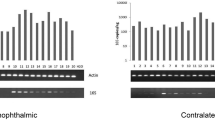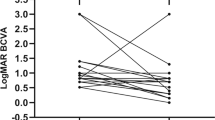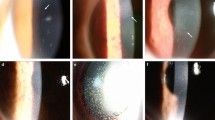Abstract
Purpose To find out if varicella zoster virus is the causative agent of Thygeson's superficial punctuate keratitis.
Methods Epithelial cells were harvested from the punctuate epithelial lesions 9 patients with Thygeson's superficial punctate keratitis. After DNA extraction polymerase chain reaction was carried out with varicella zoster virus primers.
Results All samples were negative with regard to varicella zoster virus genome.
Conclusions This result suggests that varicella zoster virus is most probably not the causative agent of Thygeson's superficial punctate keratitis.
Similar content being viewed by others
Introduction
Thygeson's superficial punctate keratitis is a chronic corneal inflammation first described in 1950.1,2,3 Its aetiology is still unclear. Virological research of Braley and Alexander4 gave questionable results in 1953, whereas Lemp et al5 were able to isolate varicella zoster virus in one patient in 1974. Here, we present a series of nine patients with Thygeson's superficial punctate keratitis with moleculargenetic analysis of corneal epithelial cells with regard to varicella zoster genome.
Patients
Mean age of five female and four male patients was 28.4 (6–52) years. Both eyes were involved in seven patients, only one eye in two patients. Thygeson's superficial punctate keratitis was diagnosed if multiple, punctate, whitish epithelial lesions with little subepithelial oedema (Figure 1), slight symptomatology, a prolonged course with remissions/exacerbations and a response to immunomodulative therapy (topical steroids or cyclosporin A6) were present. Mean duration of symptoms was 55.9 (2–156) months. Analysis followed the tenets of the Declaration of Helsinki, and written informed consent was obtained to harvest epithelial cells from punctate epithelial lesions. If both eyes were involved, the eye with the more pronounced epithelial lesions was included in the analysis. Cells were softly taken from the corneal epithelial lesions using tiny brushes (Accellon™ Multi, Medscan Medica AB, Malmö, Sweden). Thereafter, the brushes were taken into suspension with BSS® and immediately frozen at −80°C.
DNA extraction was made with the QIAmp DNA Mini Kit (Qiagen, Germany) according to the manufacturer's protocol. Two rounds of PCR were carried out using 5 μl of the extracted DNA in a total of 100 μl. Taq DNA polymerase (2 U) was used according to the manufacturer's instructions (Promega, Germany). In the first round primers VZV1 (5′-ATG TCC GTA CAA CAT CAA CT-3′) and VZV2 (5′-CGA TTT TCC AAG AGA GAC GC-3′) and in the second round primers VZV3 (5′-ACA TCC ACC GGA AGC CCA TGA-3′) and VZV4 (5′-CGG TCG ATC GAA TTA CGG GCC-3′) were used. These sequences were derived from the sequence of VZV ORF4 (Genebank accession number AY034034). In both rounds of PCR, amplification was done for 34 cycles, each consisting of 1 min at 94°C, 1 min at 40°C, and 2 min at 68°C after an initial denaturation at 94°C for 4 min and followed by a final elongation step at 68°C for 5 min. The products of the second PCR (159 bp) were visualized by electrophoresis in 1% agarose gels and staining with ethidium bromide. All samples were negative with regard to varicella zoster virus genome.
Comment
Diagnosis of Thygeson's superficial punctate keratitis is made if multiple, punctate, whitish lesions occur in the corneal epithelium.1,2,3,4,5,6 Similar, but not identical, corneal epithelial lesions were described in varicella zoster virus keratitis.7 The tendency to recur over years suggests that an unknown virus, possibly varicella zoster virus, is causative. Lemp et al5 were able to isolate varicella zoster virus from the corneal surface of a 10-year-old boy with Thygeson's superficial punctate keratitis. In their paper, they discuss, however, that the presence of the virus may be a fortuitous event not related to Thygeson's superficial punctate keratitis.5 Using modern moleculargenetic methods, varicella zoster virus genome could not be detected in any patient of the present analysis. This result suggests that varicella zoster virus is most probably not the causative agent of Thygeson's superficial punctate keratitis.
References
Thygeson P . Superficial punctate keratitis. J Am Med Assoc 1950; 144: 1544.
Thygeson P . Further observations on superficial punctate keratitis. Arch Ophthalmol 1961; 66: 158–162.
Thygeson P . Clinical and laboratory investigations on superficial punctate keratitis. Am J Ophthalmol 1966; 61: 1344–1349.
Braley AE, Alexander RC . Superficial punctate keratitis. Isolation of a virus. Arch Ophthalmol 1953; 50: 147–154.
Lemp MA, Chambers RW, Lundy J . Viral isolate in superficial punctate keratitis. Arch Ophthalmol 1974; 91: 8–10.
Reinhard T, Sundmacher R . Topical cyclosporin A in Thygeson's superficial punctate keratitis. Graefe's Arch Clin Exp Ophthalmol 1999; 237: 109–112.
Jones BR . The differential diagnosis of punctate keratitis. Trans Ophthalmol Soc UK 1960; 80: 665–675.
Author information
Authors and Affiliations
Corresponding author
Rights and permissions
About this article
Cite this article
Reinhard, T., Roggendorf, M., Fengler, I. et al. PCR for varicella zoster virus genome negative in corneal epithelial cells of patients with Thygeson's superficial punctate keratitis. Eye 18, 304–305 (2004). https://doi.org/10.1038/sj.eye.6700621
Received:
Accepted:
Published:
Issue Date:
DOI: https://doi.org/10.1038/sj.eye.6700621
Keywords
This article is cited by
-
Thygeson’s superficial punctate keratitis
Graefe's Archive for Clinical and Experimental Ophthalmology (2022)
-
Thygeson’s superficial punctate keratitis (TSPK): a paediatric case report and review of the literature
BMC Ophthalmology (2021)
-
Using pre-existing social networks to determine the burden of disease and real-life needs in rare diseases: the example of Thygeson's superficial punctate keratitis
Orphanet Journal of Rare Diseases (2021)




